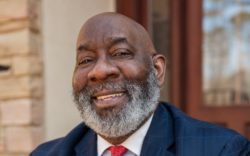Thanks to a Head Start grant, the West Broad School campus will be converted into an early learning center after all—but only for the youngest children, and on a tight timeline. Meanwhile, historic preservation activists are insisting that the Clarke County School District can save one building on the site that architects plan to tear down.
The $3.9 million federal grant’s catch is that CCSD must complete the project and open the new early learning center by Mar. 1, 2022. That’s just 11 months to appoint a building committee to vet the project, then design and build it. Both Superintendent Xernona Thomas and Director of SPLOST John Gilbreath described the timeline as “aggressive,” and to meet it, they said CCSD must start construction less than three months from now.
The challenge, however, is that the fate of one historic building at the segregation-era school is still in dispute. The goal of the project is twofold: to preserve and acknowledge an era in local Black history, and to create space for an overflow of infants and toddlers eligible for early learning programs. A 1938 building facing Minor Street, the city’s oldest surviving African-American school, will be restored. But CCSD and the preservation group Historic Athens are at odds over whether another building facing Campbell Lane—notable because it was built in the “equalization era” of the 1950s, when Southern school systems were trying to fend off integration by improving facilities for Black children—can be saved.
As planned, the new early learning center will include 16 classrooms and serve up to 128 children under the age of 4, as well as a media center, historical archive, meeting rooms, offices and parking. The facility is needed because 37% of Clarke County’s 6,700 children age 0-3 are from families eligible for Head Start, according to Karen Higginbotham, director of the Office of Early Learning. The federal program helps low-income children with their cognitive, social and emotional development, preparing them for literacy when they reach elementary school.
Originally, former superintendent Demond Means’ plan for the campus called for 200 students encompassing both Head Start/Early Start and pre-kindergarten. However, at a little over 3 acres, the campus is too small to meet the criteria for pre-K. Nor will the project include space for community use except after school hours, per federal requirements. “When we looked at space availability, all that could not be accommodated,” Thomas said at a town hall meeting Mar. 30.
At the meeting—archived on YouTube—architects presented seven options for a new building replacing two others on the campus and the existing courtyard.
Historic Athens is an official partner with CCSD and supports the use, but in a letter to CCSD last week, the organization expressed opposition to plans to tear down the Campbell Lane building. The group called on CCSD to either replace architectural firm Lindsay Pope Brayfield & Associates because of its “generic, ill-fitting approach,” or appoint Barbara Black, the historic preservation expert assigned to the project, as the principal architect alongside a new project manager, because her expertise has been restricted to the Minor Street building alone. Other architects and preservation experts who’ve examined the Campbell Lane building say it can be saved, Historic Athens Executive Director Tommy Valentine wrote in the letter, which was co-signed by local civil rights leaders Ken Dious and Fred Smith Sr.
“Given our community’s and nation’s increasing awareness of the history of the erasure of African Americans spaces, it is more important than ever to have a committed and conscious team in place to protect the heritage of this community that is reflected in this site,” Valentine wrote. “It would be a false choice to suggest that we cannot prepare for the future of the site while also properly honoring its past.”
However, Black and fellow LPB architect Margaret Beaty told Flagpole that the Campbell Lane building must go because it doesn’t meet code, would be extremely expensive to restore and interferes with stormwater drainage. “I think when it’s done, everyone will be happy,” Beaty said.
At the meeting, Smith spoke out about the importance of preserving buildings of significance to Athens’ Black history that have often been neglected or torn down, and said he wants to see the same resources put into restoring a historically all-Black school as were put into Barrow Elementary, a Jim Crow-era school for white children of similar age. “It’s almost like when you knock down history, you forget about history,” Smith said.
The Board of Education already devoted $10 million in sales-tax revenue to the project in 2019, at the expense of planned renovations to 50-year-old Clarke Middle School. The vote came after years of wrangling over what to do with the long-vacant West Broad Campus. First, Means’ predecessor, Philip Lanoue, proposed converting the campus into administrative offices. That became mired in politics related to the Athens Land Trust’s community garden and farmers market operating on the property at the time. The ALT submitted a plan to turn the property into a community center that Means rejected in favor of pre-K.
Although architects presented the destruction of much of the campus as a fait accomplis, Thomas said she will ultimately make the decision in collaboration with other administrators, architects and the building committee, which she hopes to appoint shortly after spring break. “Based on space needs, we’ll have to carefully consider what needs to be done,” she said.
Like what you just read? Support Flagpole by making a donation today. Every dollar you give helps fund our ongoing mission to provide Athens with quality, independent journalism.










